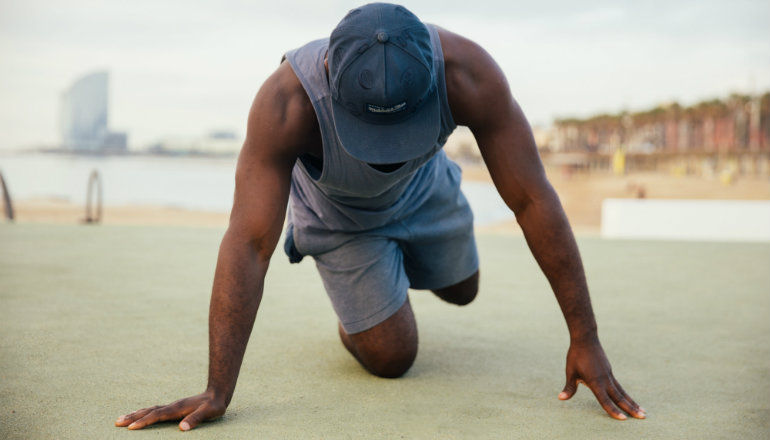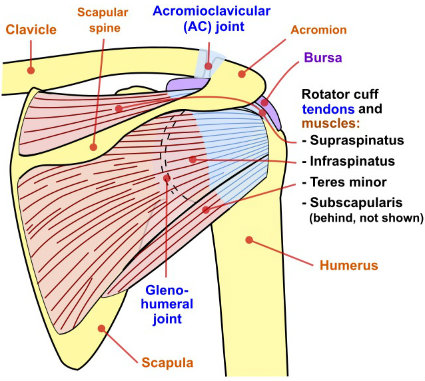
Shoulder injuries are a common ailment among many of us who train frequently — and these days that seems to include younger and younger athletes, as well. We shouldn’t be living in a world where high school athletes are being sidelined due to surgery on their rotator cuff and surrounding shoulder anatomy. We should be doing more for the health of our shoulders before there’s a problem.
Today’s article is going to address that very thing. We’re going to go over the cause of many rotator cuff injuries and several shoulder exercises that can help bulletproof your joints against the unnecessary aches and pains many of us accumulate through years of weak tissues combined with bad movement patterns.
How Exercise and Sport Related Rotator Cuff Injuries Happen
 The rotator cuff is comprised of several muscles and tendons that connect the humerus (the upper bone of the arm) to the shoulder socket. These muscles and tendons aid in moving the arm and shoulder through the wide range of motion of which it should be capable — but that most of us lack because of restricting our movement to only a small portion of that range.
The rotator cuff is comprised of several muscles and tendons that connect the humerus (the upper bone of the arm) to the shoulder socket. These muscles and tendons aid in moving the arm and shoulder through the wide range of motion of which it should be capable — but that most of us lack because of restricting our movement to only a small portion of that range.
The common daily posture for most of us involves rounded shoulders and a curved thoracic spine. This position is at the crux of where a lot of shoulder injuries come from. By spending eight or more hours in this position every day, certain rotator cuff muscles become short and stiff while others become overextended and weak.
This position sets us up for injury when we then participate in our chosen exercise or sport. If your shoulder position is compromised and you engage in activities that include overhead pressing or throwing, you’re going to eventually cause yourself injury. Muscles and tendons in the shoulder, like anywhere in the body, will compensate the best they can in a less-than-ideal situation. When they have to work in a position they weren’t intended to over a long period of time, then you will eventually have an injury that can be as mild as inflammation of the tissues or as major as a rotator cuff tear that requires surgery to reattach it.
How to Strengthen Your Shoulders (a Little at a Time)
One way to combat this problem is to begin strengthening the back of the shoulders in conjunction with working on your posture. It’s important to work on this problem from both directions otherwise your efforts will be for naught.
The videos below will detail exercises that will help to limber up and strengthen your shoulders. This will help provide balance, strength, and stability to your shoulder joints. With time and consistency, any joint pain you have may be resolved and you’ll greatly reduce your risk of training-related shoulder injuries.

For any of these exercises that involve weight, you should begin with very light amounts and only increase the amount when the weight you’re using feels too easy. I generally start my clients with 2.5 pounds and no more than 5 pounds. This allows the muscles to properly adapt without risking unnecessary strain or injury.
It’s important to remember that if your shoulders haven’t had any focused training, then they’re not going to be as strong as the rest of your upper body. Given the potentially delicate nature of the muscles surrounding the shoulder, it’s best to approach these exercises from a conservative perspective and not rush into too much weight too soon.
1. The YTW Series
The YTW series is a great one for developing various forms of pulling with the shoulders and upper back as it addresses different angles and rotations of the shoulders. This series can be done with either a pronated or a supinated grip depending on your needs.
2. The Shoulder Shrug
The shoulder shrug is a great exercise for developing strength in the shoulders. When done properly you can learn to exert a level of control over your shoulders that will have eluded you before. This will not only improve your push-ups and horizontal pressing strength, but the mobility in your scapula, too. These also make a great warm-up or cool down for the shoulders.
3. Cuban Presses and Rotations
Cuban presses and rotations are two different exercises. Presses contain the element of rotations but they also include an overhead press at the top of each rep.
These are fantastic for developing the rotational strength of your shoulders. This is important for learning to engage and exert control over our lats and other large muscles of the upper back rather than relying solely on the smaller muscles of our shoulders alone.
4. Seated Rotations
Seated rotations serve the same function as the Cuban rotations, but they have the added benefit of allowing you to focus on the rotation of the shoulder, lats, and upper back. The bonus is for those of us who may not have a great deal of control over these muscles or aren’t aware of what the necessary type of contraction feels like. This exercise is great for learning how proper shoulder rotation should feel and which muscles you should be using.
A Rotator Cuff Injury Doesn’t Have to Happen to You
Rotator cuff injuries are all too common — but they needn’t be. With judicious application of these different exercises, you can develop shoulder strength and stability that you never realized was possible. When it comes to exercise, little and often over the long term will lead you to sustained success in your fitness and health.
